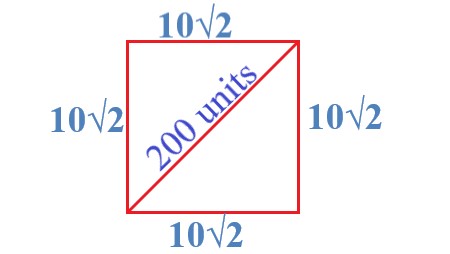Lesson Topics Discussion Quiz: Class Homework |
Example1 |
Title: Area of Square |
Grade 6+ Lesson s1-l5 |
Explanation: The best way to understand geometry is by looking at some examples. Take turns and read each example for easy understanding. |
Examples
Topics → Definition Example1 Example2
The diagonal of a square is 20 units. Find the area & length of each side of the square.

Step: 1 |
|
In this case, let’s assume that each side of the square has a length of x units. A square’s diagonal is 20 units. |
|
Explanation: |
|
In this step, let’s assume that each side of the square has a length of x units. The given diagonal of the square is 20 units. When we apply the Pythagorean theorem to the equation, we get \$x^2 + x^2 = 20^2\$. Simplifying it, we get 2x^2 = 400, and then further simplifying to \$x^2 = 200\$. |
|
Step: 2 |
|
Taking the square root of both sides, to find: |
|
Explanation: |
|
By taking the square root of 200, we get x = 10√2.Therefore, the length of each side of the square is 10√2 units. |
|
Step: 3 |
|
To find the area of a square: |
|
Explanation: |
|
In this step, find the area of a square. The formula is \$side \times side\$, which means, in this case, it’s \$10√2 \times 10√2\$. Therefore, the area is 200 sq. units. |
|
Copyright © 2020-2024 saibook.us Contact: info@saibook.org Version: 4.0 Built: 17-Sept-2025 12:00PM EST